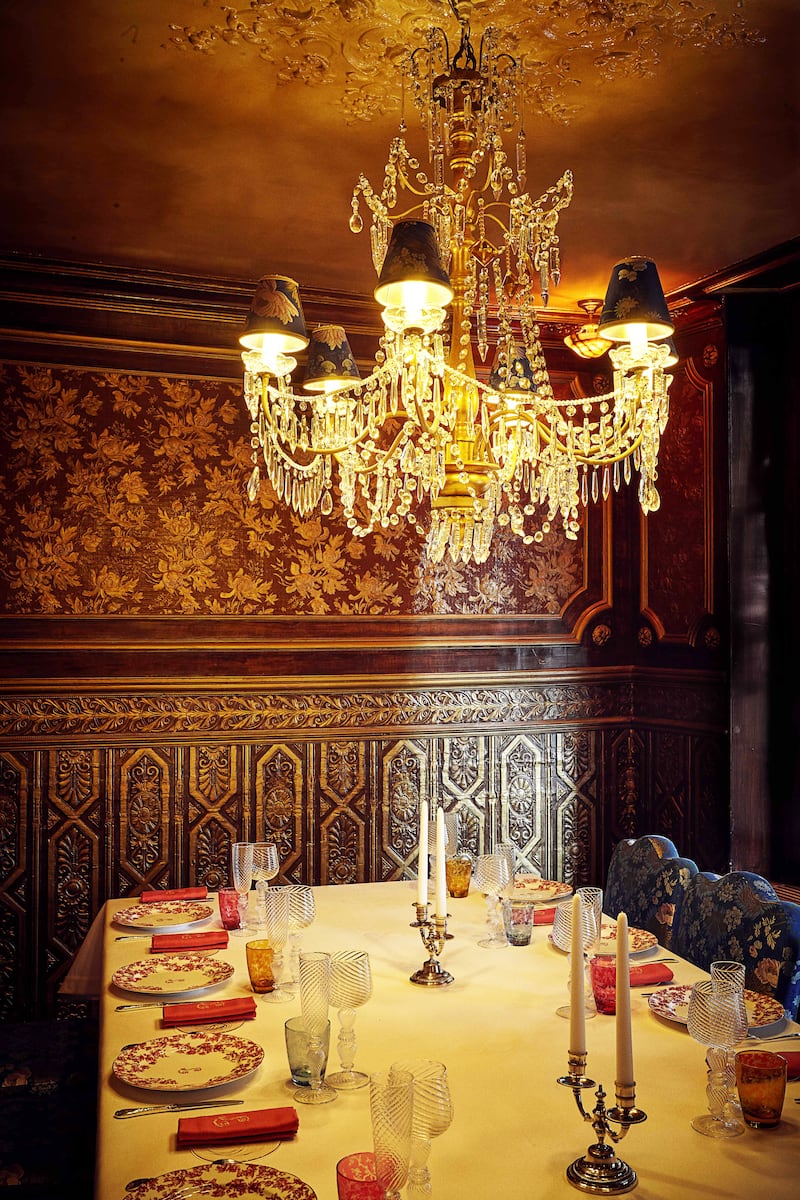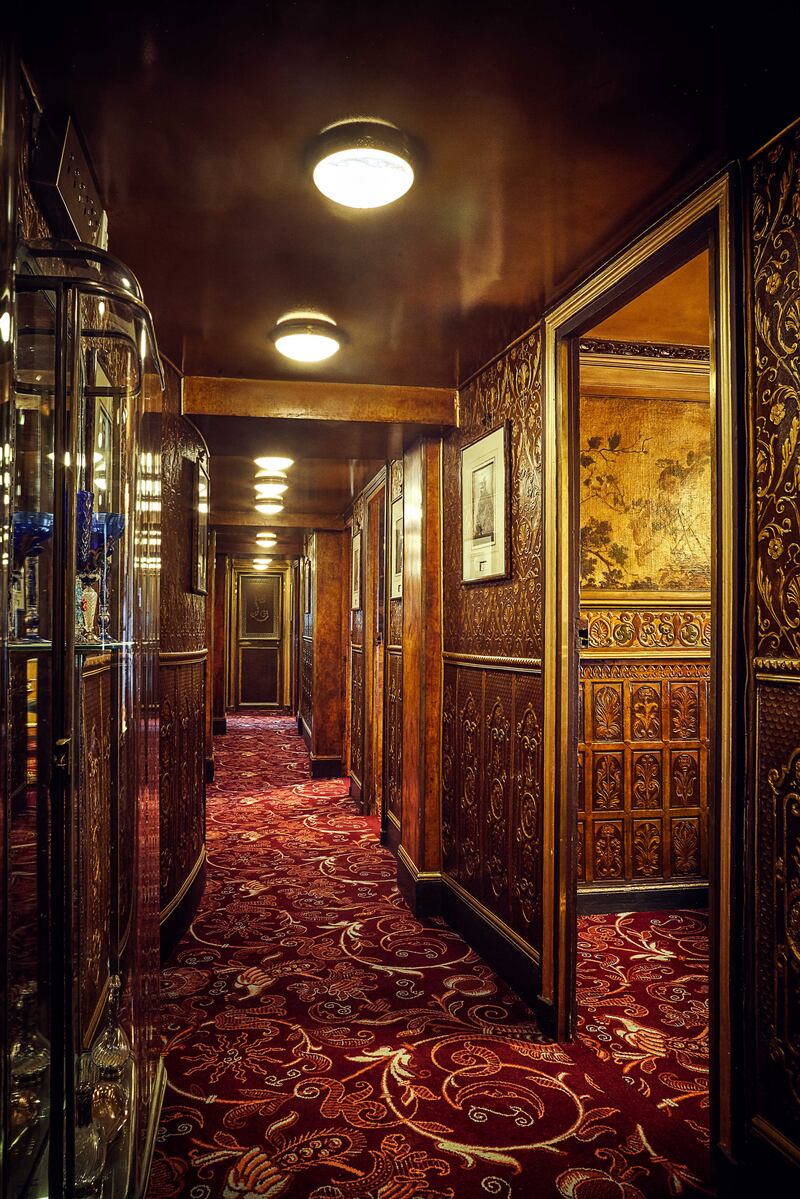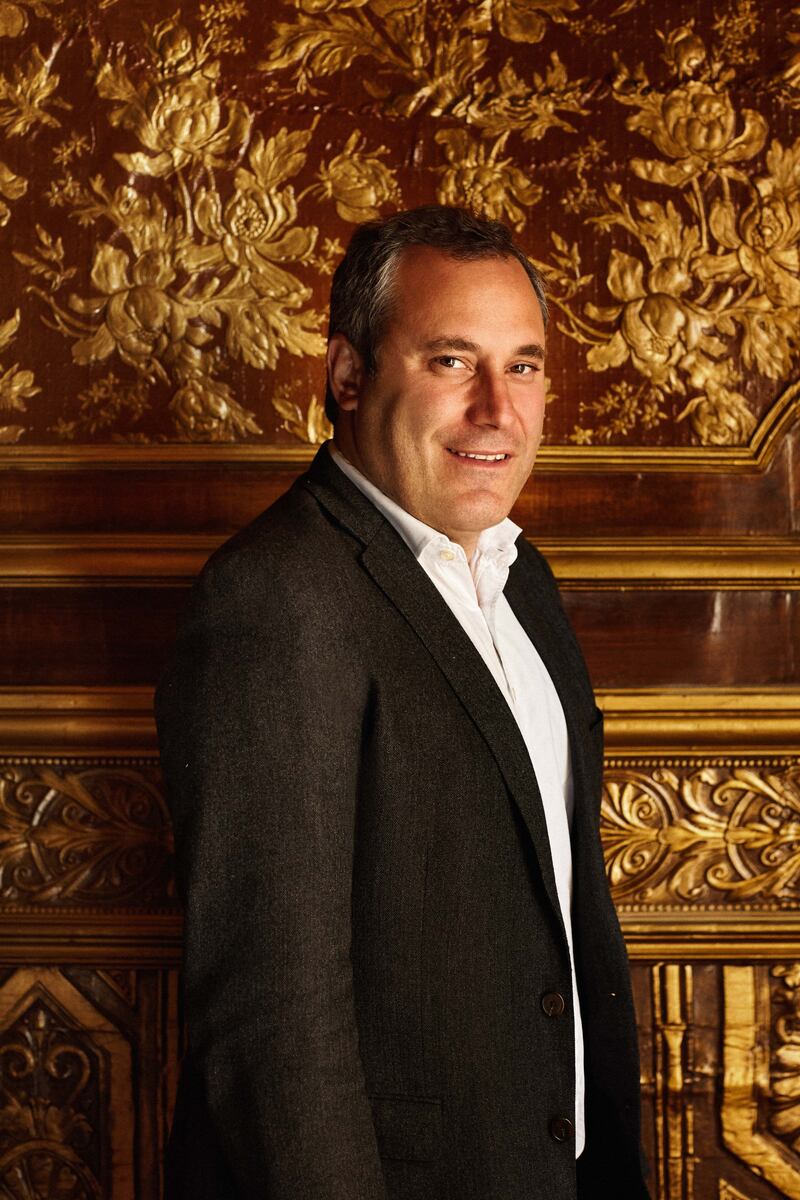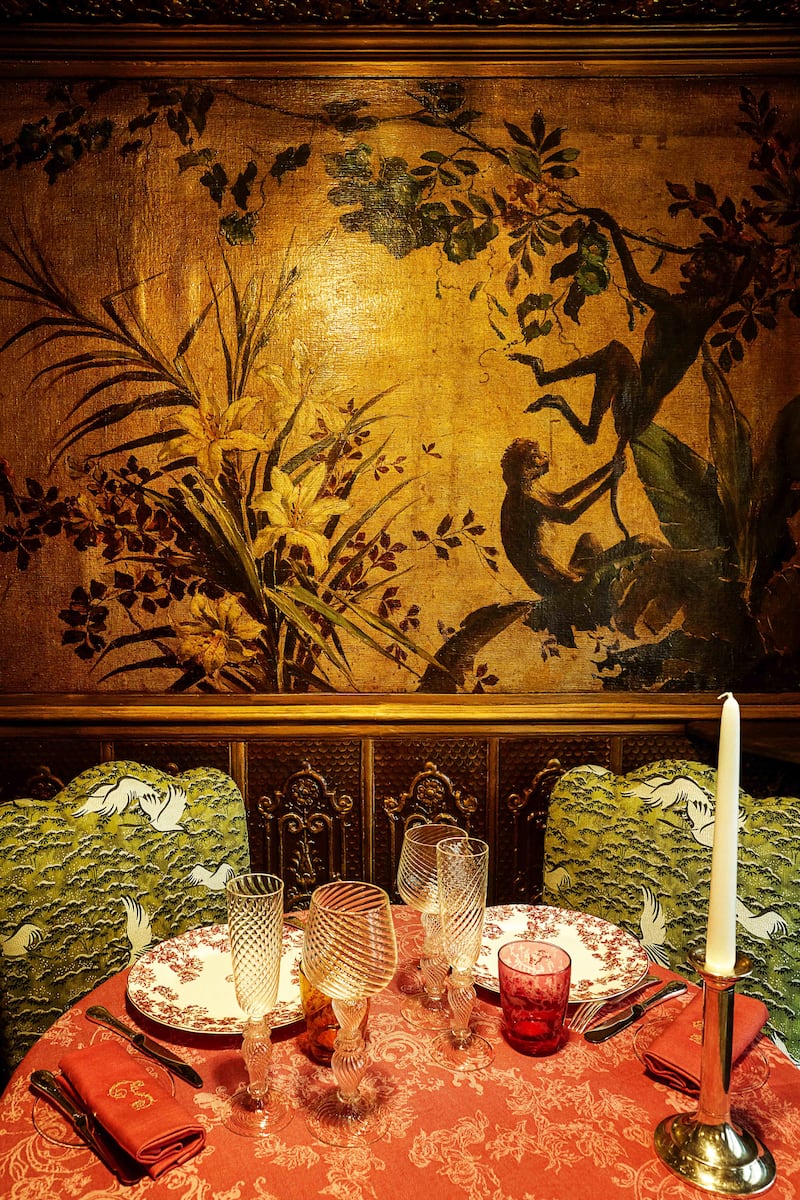I never really thought about savoring haute cuisine with a side of sex until I discovered Lapérouse.
A Paris institution, the legendary three-story eatery with the cobalt-blue façade has stood at 51 Quai des Grands Augustins near the banks of the Seine since 1766, and became a hotspot over the decades for the city’s literary (Victor Hugo and Charles Baudelaire were regulars) and political luminaries. And thanks to its salons privés (private dining rooms), the restaurant also served as a discreet setting for risqué romps between affluent gentlemen and their mistresses. At one point, there was even a secret tunnel connecting the decadent joint with the French Senate, allowing philandering politicians to slip in and out undetected.
“The most widespread view of Paris is that of a city that blends epicurean, romantic and sexual pleasures,” French historian Adrien Lecoursonnais writes in Lapérouse, a slim biography of the restaurant’s 250-year history. “Lapérouse is thus one of those addresses of libertinism that makes Paris the ‘capital of gastronomy’ as much as ‘the brothel of Europe.’”
Said libertine address has recently reopened following a four-month renovation, and although its new owner christened it Maison de Plaisirs (House of Pleasures), the eatery’s origins were more practical than scandalous. Built as a private mansion, Lapérouse was founded in 1766 by King Louis XVI’s personal beverage maker and functioned as a wine market. The second-floor servants’ quarters were transformed into salons privés, and were used by wealthy merchants, not for debauched dalliances, but as spaces where they could discreetly count their money and balance the books without the fear of being robbed by street bandits.

The restaurant became Lapérouse in the mid-1800s when Jules Lapérouse took over, and its popularity boomed in the decades that followed. Literary lions like Baudelaire, Hugo, Marcel Proust, and George Sand flocked to the elegant haunt with the Rococo interior and gourmet cuisine, and it was at Lapérouse that Colette reportedly penned her 1933 novel, La Chatte.
It was also during this century that the tiny rooms hosted illicit dinners à deux between rich gentlemen and women they weren’t married to. Often gifted with jewelry, the mistresses would scratch the bling against the restaurant’s mirrors to confirm that the gems were authentic. If the diamond left behind a scratch, it was the real deal. The scratched mirrors have since become emblematic of Lapérouse and of the numerous clandestine liaisons held in its petits salons.
The 20th century brought new fame to 51 Quai des Grands Augustins. In 1933, it became one of the first restaurants in Paris to be awarded three Michelin stars—an accolade that lasted for around three decades. A new generation of political heavyweights and bright young things frequented the restaurant, including Ernest Hemingway and other members of the famed Lost Generation that converged on Paris in the 1920s. In a letter to his sister, Hemingway remarked that one could “eat better at Lapérouse,” than at other renowned addresses in the city such as La Tour d'Argent. Serge Gainsbourg is rumored to have met Jane Birkin there, and former French president François Mitterrand reportedly lunched at Lapérouse with his illegitimate daughter Mazarine (in a salon privé, of course).
Lapérouse was also a hangout for members of the ‘90s-era fashion crowd, including supermodel Kate Moss, who scratched "It's 2 late 2 go 2 bed" on one of the mirrors during an after-hours party. It also stood in for the iconic Jazz Age-era hangout, Chez Bricktop, in Woody Allen’s 2011 Midnight in Paris. More recent celebrity visitors have included George Clooney, Natalie Portman, and Nicole Kidman.

Over the past decade, however, Laperouse’s sumptuous sheen began to give way to shabbiness. The carpets were slightly worn-looking, as were the plush, wine-red loveseats in the salons privés. The food was decent, but a far cry from what the kitchen turned out during the restaurant’s triple Michelin-starred heyday. Many patrons, myself included, only came for the novelty. A slightly bland, overpriced cut of meat somehow tastes juicier if you’re eating it in the same room that Charles Baudelaire may have once smoked opium and jotted down morose stanzas about aging prostitutes and dusty chandeliers.
Because of this, I was able to overlook the lackluster menu and the tourists in stodgy pullovers that populated the main dining room during my first visit a couple of years ago. As the witness to so many deliciously decadent moments throughout history, the restaurant’s intrigue lay in the vestiges of thousands of torrid evenings past, like the Senate passage’s boarded up entrance and the tangle of graffiti-like etches on the Venetian mirrors.
For others, however, the restaurant was no longer even on the radar. Several of my Paris-based friends hadn’t heard of it, and neither had a well-traveled couple I recently bumped into who were visiting from London. It was as though Lapérouse, home to so many ghosts of Paris’s past, had itself become a ghost of its former more vivacious incarnations.
“It resembles more a museum than a restaurant," one diner complained in a disgruntled Trip Advisor review posted in January. “It’s too bad, it would be worth it to renovate everything a bit…The food is not very good.”

Enter Benjamin Patou. The head of the city’s restaurant and nightlife group, Moma, Patou first set his sights on Lapérouse some 20 years ago during a PR gig. Describing the first time he entered the restaurant as “love at first sight,” Patou was determined to purchase Lapérouse one day. After two failed attempts, he finally succeeded with the help of Antoine Arnault of the luxury goods empire LVMH.
Patou told The Daily Beast that the biggest challenge in the restaurant’s revamp was to completely refurbish the space without removing its soul.
“I wanted the clientele to have the impression that it hadn’t changed, that it had always looked like this,” he explained.

Benjamin Patou
Matthieu SalvaingTo celebrate the restaurant’s rebirth, Patou held a masked ball in late-June during men’s fashion week. Some 500 sartorially savvy revelers filled the eatery’s maze of narrow corridors and salons privés. Russian supermodel Natalia Vodianova dropped by, as did French chanteuse Arielle Dombasle. Adding to the 19th-century-style glamour were costumed performers and burlesque dancers, mounds of caviar, and many cases of champagne. French director Claude Lelouch even filmed the fête in action, explaining that the images would be used for his upcoming flick, Les Fantômes de Lapérouse.
Chic soirées are all well and good, but the real question was whether the new Lapérouse could hold its own sans the presence of supermodels or sultry dancers. Determined to find out, I booked a reservation with my French partner, henceforth known as Monsieur. Although I reserved a week in advance, there was only one salon privé available. A good sign. Our two previous bookings were last-minute ones—further proof of the place’s diminished popularity. I slipped on a little black dress and headed for the Left Bank.
Monsieur was late, so I took the opportunity to take a good look around the revamped bar area. Patou recruited both interior design and restoration firms for the project, and the result is striking, but subtle. The red and slate-blue color scheme has been replaced with dusty rose and forest-green hues, and heavy velvet upholstery on the chairs and couches has been traded in for damask silk. Better yet, there was air-conditioning—a much-needed upgrade, especially on a sticky July evening.
After Monsieur arrived, our server Nicolas led us upstairs to a jewel box-sized room on the second floor called La Belle Otéro. Named for Belle Époque-era Spanish courtesan Carolina Otéro, whose roster of lovers included the likes of Albert I of Monaco and King Edward VII, the snug space has just enough room for a table for two and a loveseat. A restored fresco depicting monkeys and lilies adorned one wall, and the table was decorated with crystal glassware and a single candle.

Nicolas gestured to the vintage-style wall button on the left side of the table—a remnant of the restaurant’s earlier age—explaining that pressing the buzzer gives servers the go ahead to enter. Otherwise, the wooden door with its etched glass window would remain shut throughout the duration of the meal. I winked at Monsieur from across the table, and then we dove into the vast wine list. Lapérouse is renowned for the thousands of bottles in its cellar, many of them rare vintages.
“How about a 2002 Petrus?” he joked. The prized red would have set us back €9000, ($10,100) so we passed it over for a Bordeaux that cost significantly less than a weeklong getaway.
The new menu is small and is rooted in French classics, including duck foie gras, pigeon, and pig’s foot. Patou tapped Michelin-starred chef Jean-Pierre Vigato to create Lapérouse’s dishes, despite the latter’s initial resistance.
“I told Benjamin Patou, not the Left Bank and definitely not Lapérouse!” Vigato said, as quoted in a news release. “What changed my mind was this unique, magical, legendary Parisian venue. We have decided to draw inspiration for our menu from its history, with classic service in the traditional manner.”
The new dessert menu is in the hands of pastry chef Christophe Michalak, who previously worked at the prestigious Hôtel Plaza Athénée and heads up several pastry shops in the city.
We started with foie gras (hard to mess up) and champagne, and for the main I went for the rouget barbet (striped red mullet) with a yellow curry sauce. The small filet was buttery and tender, and while the sauce was a shade too salty for my liking, it was served on the side and didn’t overwhelm the flavor of the mullet. Net yet at Michelin-star levels, but definitely an improvement over previous encounters with Lapérouse’s menu. The tableware—heavy silver plates and plain white china—of yore has been swapped for more whimsical designs by Dior Maison creative director Cordelia de Castellane, and includes monogrammed plates with floral borders.
As the evening wore on, I was relieved to discover that the changes at Lapérouse comprised more of a restoration than a renovation. Its candlelit rooms are still heavy with history and the ambiance still seductive, but subtle flourishes of 21st-century luxury have given the interior a fresh sparkle. Plus there’s the air conditioning, which, as anyone who lives here knows, is a true luxury in France. I was happy to report that Patou had succeeded in his quest to add a newfound polish to the place while still honoring its past.

After finishing our mains, we moved to the loveseat. The sage-green upholstery printed with images of cranes in mid-flight matched the dining chairs, and seemed an oddly Zen backdrop for a tawdry horizontal tryst. More perplexing was the loveseat’s squat size, which immediately ruled out any possibility of a languorous lovemaking session. If memory serves, the previous red velvet couches, though well-worn, were significantly longer. How would a modern-era Belle Otéro manage? Would she have to be exceptionally short? Keen on quickies? Game to go at it on the floor? Monsieur leaned in for a kiss anyway.
Before long we were making out on the too-small “Zen couch.” Strains of Ella Fitzgerald and Louis Armstrong’s 1957 rendition of “Let’s Call the Whole Thing Off” filtered out of the speaker in the corner, and I nearly fell off the loveseat. Calling it off actually seemed like a wise suggestion. Monsieur, however, didn’t seem bothered. I shot a wary glance at the door’s frosted window. Silhouettes flickered across the glass, but no one opened the door. Nicolas had been (thankfully) telling the truth about the buzzer.
So what happened next? Did we pay homage to the revived Parisian legend and its bevy of courtesans past in a way that would have made Carolina Otéro blush? Or did we acknowledge that a loveseat romp was better suited for a couple of lascivious munchkins, opting instead to cap off the evening with caramel-drizzled dark chocolate, soft, spongy madeleines and the last of the wine?
I’ll leave it to your imagination. Lapérouse may be a Maison de Plaisir, but more than two-and-a-half centuries later it remains, above all, the City of Light’s most discreet address.

